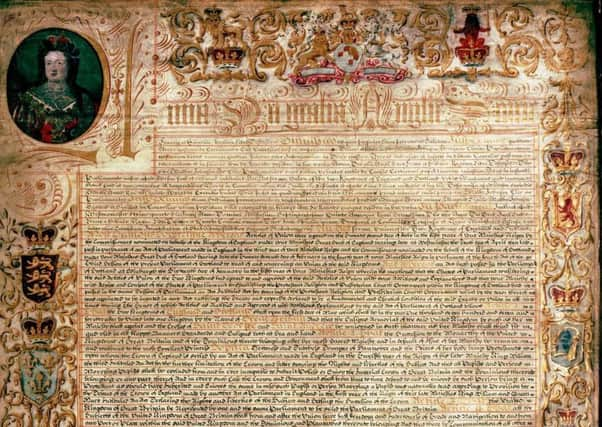On this day 1707: Treaty of Union signed by Scottish Parliament


On January 16, the Act ratifying the treaty was finally passed by 110 votes to 69 with the nobility forming the largest pro-Union group.
The treaty’s passage through parliament coincided with deep pockets of dissent in Scotland’s towns and villages.
Advertisement
Hide AdAdvertisement
Hide AdIn Edinburgh a ‘villanous and outragious mobb’ threatened and insulted judges and Members of the Scottish Parliament, according to an account held by National Library of Scotland.
Rewards were offered for the capture of rioters with the more wealthy resident of our burghs urged to take responsibility for the actions of their staff and servants.
“In Glasgow, Dumfries and Lanark people had taken up arms: they were ‘insolently burning the Articles of Treaty betwixt our two Kingdoms’.
“Sheriffs, baillies and magistrates were authorised to take whatever action necessary to quench the riots,” the account said.
Advertisement
Hide AdAdvertisement
Hide AdBy December 1706, parliament was ordering the burning of pamphlets that challenged the proposed union with the papers to be destroyed by the hangman at Edinburgh’s Mercat Cross. Further proclamations were made against so-called seditious meeting.
Meanwhile, parliamentarians were engaged in their own manoeuvres as work intensified to push the treaty through.
Lord Queensberry was appointed the Queen’s High Commissioner for the parliamentary session that would decide upon the treaty and was tasked with insuring a successful outcome.
Honours, appointments, pensions and even arrears of pay and other expenses were distributed to secure support from Scottish peers and MPs.
Advertisement
Hide AdAdvertisement
Hide AdThe treaty’s 25 articles were debated and approved between October 1706 and January 1707.
Economic matters were dealt with by the majority of articles with new flags and coinage also addressed.
It was agreed customs and excise charges would be set equally across the kingdom with Scots law and the country’s distinct education system to remain.
Critically, the Hanoverian line of succession to the Crown was confirmed - and the exclusion of Papists from the throne agreed.
Advertisement
Hide AdAdvertisement
Hide AdUnder the Treaty of Union, Scotland was paid £398,000 - a sum known as ‘the Equivalent’. This would partially offset losses incurred by the failed Darien Scheme to set up a colony in the Isthmus of Panama.
It would also compensate Scotland for sharing the responsibility for England’s national debt of £18 million.
After the Scottish Parliament ratified the treaty, it turned to the question of Scotland’s future parliamentary representation.
Article 22 of the Treaty set out that Scotland was to be represented by 16 peers and 45 commoners.
Advertisement
Hide AdAdvertisement
Hide AdAt the time, more than 300 representatives made up the Scottish Parliament, with just under half of its members hereditary peers.
Deep resentment among the public was stirred by this reduced representation at Westminster.
The Scottish Parliament continued to sit until 25 March 1707. The Queen’s Commissioner in Scotland, the Duke of Queensberry, ended its proceedings.
He urged the members to ‘… promote an universal desire in this kingdom to become one in hearts and affections, as we are inseparably joyn’d in interest with our neighbour nation’.
The Scottish Parliament did not meet again until May 12, 1999.
